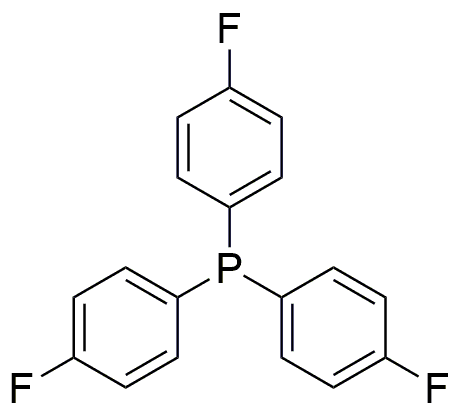Tris(4-fluorophenyl)phosphine is widely utilized in research focused on:
- Organic Synthesis: This compound serves as a versatile reagent in the synthesis of various organic molecules, particularly in the development of pharmaceuticals and agrochemicals.
- Catalysis: It acts as a ligand in transition metal catalysis, enhancing reaction efficiency and selectivity in processes such as cross-coupling reactions, which are crucial in the production of fine chemicals.
- Material Science: The compound is used in the development of advanced materials, including polymers and nanomaterials, due to its unique electronic properties.
- Fluorescent Probes: Tris(4-fluorophenyl)phosphine can be employed in the creation of fluorescent probes for biological imaging, allowing researchers to visualize cellular processes in real-time.
- Pharmaceutical Development: Its application in drug discovery helps in the design of new therapeutic agents, particularly those targeting specific biological pathways, offering potential advantages over traditional compounds.
General Information
Properties
Safety and Regulations
Applications
Tris(4-fluorophenyl)phosphine is widely utilized in research focused on:
- Organic Synthesis: This compound serves as a versatile reagent in the synthesis of various organic molecules, particularly in the development of pharmaceuticals and agrochemicals.
- Catalysis: It acts as a ligand in transition metal catalysis, enhancing reaction efficiency and selectivity in processes such as cross-coupling reactions, which are crucial in the production of fine chemicals.
- Material Science: The compound is used in the development of advanced materials, including polymers and nanomaterials, due to its unique electronic properties.
- Fluorescent Probes: Tris(4-fluorophenyl)phosphine can be employed in the creation of fluorescent probes for biological imaging, allowing researchers to visualize cellular processes in real-time.
- Pharmaceutical Development: Its application in drug discovery helps in the design of new therapeutic agents, particularly those targeting specific biological pathways, offering potential advantages over traditional compounds.
Documents
Safety Data Sheets (SDS)
The SDS provides comprehensive safety information on handling, storage, and disposal of the product.
Product Specification (PS)
The PS provides a comprehensive breakdown of the product’s properties, including chemical composition, physical state, purity, and storage requirements. It also details acceptable quality ranges and the product's intended applications.
Certificates of Analysis (COA)
Search for Certificates of Analysis (COA) by entering the products Lot Number. Lot and Batch Numbers can be found on a product’s label following the words ‘Lot’ or ‘Batch’.
*Catalog Number
*Lot Number
Certificates Of Origin (COO)
This COO confirms the country where the product was manufactured, and also details the materials and components used in it and whether it is derived from natural, synthetic, or other specific sources. This certificate may be required for customs, trade, and regulatory compliance.
*Catalog Number
*Lot Number
Safety Data Sheets (SDS)
The SDS provides comprehensive safety information on handling, storage, and disposal of the product.
DownloadProduct Specification (PS)
The PS provides a comprehensive breakdown of the product’s properties, including chemical composition, physical state, purity, and storage requirements. It also details acceptable quality ranges and the product's intended applications.
DownloadCertificates of Analysis (COA)
Search for Certificates of Analysis (COA) by entering the products Lot Number. Lot and Batch Numbers can be found on a product’s label following the words ‘Lot’ or ‘Batch’.
*Catalog Number
*Lot Number
Certificates Of Origin (COO)
This COO confirms the country where the product was manufactured, and also details the materials and components used in it and whether it is derived from natural, synthetic, or other specific sources. This certificate may be required for customs, trade, and regulatory compliance.


